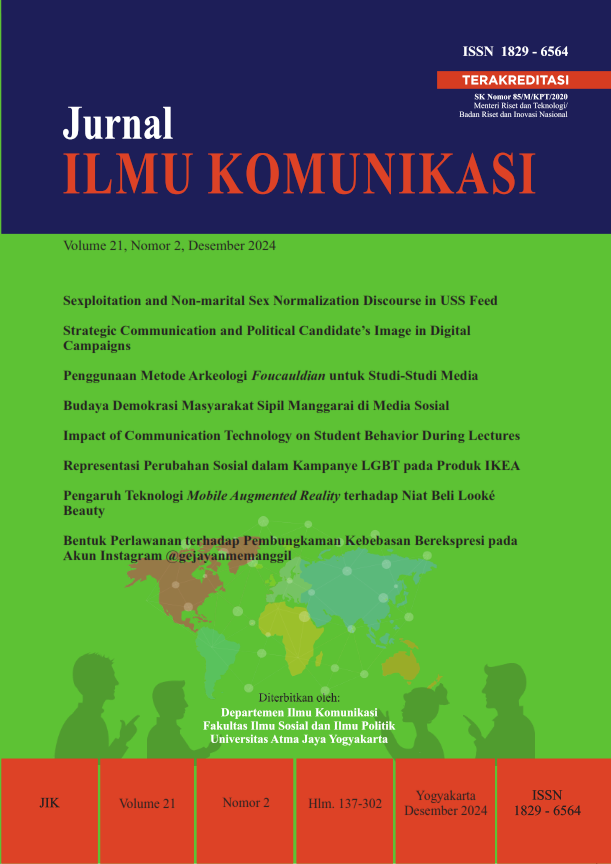Impact of Communication Technology on Student Behavior During Lectures
DOI:
https://doi.org/10.24002/jik.v21i2.7634Keywords:
communication, lectures, online interaction, students, technological determinism theoryAbstract
Technological advancements have impacted education, influencing student behavior across different eras—1990s, 2000s, and today. This survey-based research uses conventional sampling techniques and supports the theory of technological determinism, showing how communication technology affects behavior, thought patterns, and social interactions. Face-to-face communication has largely been replaced by online interactions. The study finds that chatting remains a common activity while waiting for lecturers, and highlights a decline in reading habits. Instead, frequent use of mobile phone has become prevalent. The research underscores how technology reshapes both learning environments and student habits.
References
Adler, R. B., & Rodman, G. 2006. Understanding human communication. Oxford, England: Oxford University Press.
Afrilyasanti, R., & Basthomi, Y. (2022). Lower-middle-income country teachers’ Voices about distance learning methods. In Baikady, R., Sajid, S., Przeperski, J., Nadesan, V., Islam, M.R., Gao, J. (eds). The Palgrave Handbook of Global Social Problems. London, UK: Palgrave Macmillan.
Alshahrani, S., Ahmed, E., & Ward, R. (2017). The influence of online resources on student-lecturer relationship in higher education: A comparison study. J. Comput. Education, 4(2): 87–106.
Amodu, L., Omojola, O., Okorie, N., Adeyeye, B., & Adesina, E. (2019). Potentials of internet of things for effective public relations activities: Are professionals ready? Cogent Business and Management, 6(1), 1-15.
Brodjonegoro, S. S. (2023). Smartphone as polymedia for mothers during pandemic. Jurnal ILMU KOMUNIKASI, 20(1), 117–136.
Buchanan, T. (2020). Why do people spread false information online? The effects of message and viewer characteristics on self-reported likelihood of sharing social media disinformation. PLoS ONE, 15(10), 1-33.
Carey, J. W. (2009). Communication as Culture: Essay on Media and Society. Revised edition. New York, USA: Routledge.
Chen, I. H., Chen, C. Y., Pakpour, A. H., Griffiths, M. D., & Lin, C. Y. (2020). Internet-related behaviors and psychological dis-tress among school children during COVID-19 school suspension. Journal of the American Academy of Child and Adolescent Psychiatry, 59(10), 1099-1102.
Dubois, E., Minaeian, S., Paquet-Labelle, A., & Beaudry, S. (2020). Who to trust on social media: How opinion leaders and seekers avoid disinformation and echo chambers. Social Media+Society, 6(2), 1-13.
Fiske, J. (2002). Introduction to communication studies. New York, USA: Routledge-Taylor & Francis e-Library.
Griffin, E. M. (2012). A First look at communication theory. New York, USA: McGraw Hill.
Hinson, R. E., Kosiba, J. P. B., Odoom, R., & Gyampo, R. E. (2019). Dialogic features of brand South Africa’s website and tourists’ intentions to visit. European Business Review, 31(5), 568-584.
Kriyantono, R. (2019). Pengantar lengkap ilmu komunikasi: Filsafat dan etika ilmunya serta perspektif Islam. Jakarta, Indonesia: Prenada.
Kriyantono, R. (2020). Teknik praktis riset komunikasi: Kuantitatif dan kualitatif. Jakarta, Indonesia: Prenada.
Kriyantono, R., Kasim, A., Safitri, R., Adila, I., Prasetya, A. B., Febriani, N., Dewi, W. W. A., Saleh, A. M., & Said, M. F. (2023). Is social media the top priority for seeking and sharing information about COVID-19 among Indonesian students? Malaysian Journal of Communication, 39(1), 144-165.
Littlejohn, S. W., Foss, K. A., & Oetzel, J. G. (2017). Theories of human communication. Illinois, USA: Waveland Press.
Mcluhan, M. (1962). The Gutenberg galaxy: The making of typograhic man. Toronto, Canada: University of Toronto Press.
Pérez-López, R., Gurrea-Sarasa, R., Herrando, C., Martín-De Hoyos, M. J., Bordonaba-Juste, V., & Acerete, A. U. (2020). The generation of student engagement as a cognition-affect-behavior process in a twitter learning experience. Australasian Journal of Educational Technology 36(3): 132–46.
Rakhmat, J. (2008). Psikologi komunikasi. Bandung, Indonesia: Rosdakarya.
Sugiono, S. (2023). Peran komunikasi sains di media sosial pada masa pandemi Covid-19. Jurnal Ilmu Komunikasi, 20(1), 97–116.
West, R., & Turner, L.H. (2010). Introducing communication theory: Analysis and application. New York, USA: McGraw Hill.
Yap, C. S., Tiew, F. N. H., Ngadan, A. A., & Ho, P. L. (2020). Information needs and information seeking behavior of rural dwellers in Sarawak, Malaysia. Malaysian Journal of Library & Information Science, 25(2), 77-94.
Yoshua, A. (2022). Evolution of mobile phone technologies: 1G to 5G. Journal of Mobile Communications, 10(2), 45-60.
Downloads
Published
How to Cite
Issue
Section
License

This work is licensed under a Creative Commons Attribution 4.0 International License.
Jurnal ILMU KOMUNIKASI is an academic journal. As such, it is dedicated to the open exchange of information. For this reason, JIK is freely available to individuals and institutions. Authors who publish in Jurnal ILMU KOMUNIKASI will release their articles under the Creative Commons Attribution (BY) License. This license allows anyone to copy and redistribute the article in any medium or format as well as remix, transform, and build upon the material for any purpose, even commercially as long as they credit the authors for the original creation. For details of the rights authors grants users of their work, see the "human-readable summary" of the license, with a link to the full license. (Note that "you" refers to a user, not an author, in the summary)
 This work is licensed under a Creative Commons Attribution 4.0 International License.
This work is licensed under a Creative Commons Attribution 4.0 International License.














